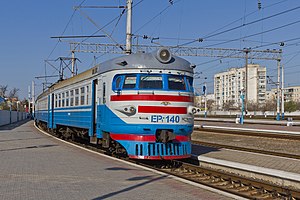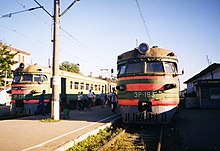SŽD series ЭР1
| SŽD series ЭР1 | |
|---|---|
| Manufacturer: | Rīgas Vagonbūves Rūpnīca |
| Year of construction (s): | from 1953 |
| Axis formula : | 2'2 '+ Bo'Bo' + 2'2 '+ Bo'Bo' + 2'2 '+ Bo'Bo' + 2'2 '+ Bo'Bo' + Bo'Bo '+ 2'2' |
| Gauge : | 1520 mm |
| Length over coupling: | 200,500 mm (10 pieces) |
| Trunnion Distance: | 13,300 mm |
| Bogie axle base: | Motor bogie: 2,600 mm running bogie: 2,420 mm |
| Service mass: | 450 t |
| Top speed: | 130 km / h |
| Hourly output : | 4,000 kW |
| Acceleration: | 0.65 m / s² (up to 60 km / h) |
| Wheel diameter: | 1,050 mm |
| Power system : | 3 kV DC |
| Power transmission: | Overhead line |
| Number of traction motors: | 20 (ten parts) |
| Seats: | 1,056 |
The ЭР1 (ER1) is a multiple unit built by the Rigaer Waggonfabrik (RVR) in Latvia specifically for fast suburban traffic.
history
The vehicles were created in 1957 as a further development of a three-part electric multiple unit that was built in 1949 and could no longer meet the increasing demands of suburban traffic. In 1957 five experimental units of the new series ЭР1 came out, which were subjected to detailed tests. Series production then started in the second half of 1958. How many vehicles were built cannot be taken from the literature.
The railcars had a higher engine power and therefore it was possible with them to achieve an acceleration of 0.65 m / s² (up to 60 km / h). At a maximum speed of 130 km / h it was possible to reach a stop for 30 s;
- at a stop distance of 2.5 km a cruising speed of 54 km / h and
- a travel speed of 71 km / h at a distance of 5 km between stops.
The vehicles were the basis for several electric multiple units especially for electrified suburban traffic. From 1962 the series folgР2 followed , which is suitable for high and low platforms. Vehicles for the alternating current range were also derived from it.
No stationing data or whereabouts can be found in the literature. The successor series ЭР2 can still be found in electric suburban traffic in Latvia in 2012 .
Technical descriptions
The multiple unit was built as a ten-part unit with the composition ES + ET + EM + ET + EM + ET + EM + ET + ET + ES. The technical data not shown also relate to the ten-piece. The multiple unit could also be formed as a 4, 6 or 8-part unit, whereby half of the cars should be multiple units in order not to reduce the driving characteristics. The multiple units were without a driver's cab (not even with an emergency driver's cab) and could therefore only run with control cars.
In terms of the basic concept, the four-axle wagons have the same structure. With the exception of a few frame parts, the railcars and intermediate cars are completely identical. The car body is a welded metal structure made of profiles and sheets and is designed as a self-supporting structure. The use of corrugated metal sheets is characteristic of the structure, which also increased the rigidity of the structure. The inner cladding consisted of a wooden frame and a veneer cladding with glued-on trim material.
The car body has been designed as a large compartment with a central aisle. Each car had 9.5 compartments with a seating arrangement of 3 + 3 and an aisle width of 616 mm. The control car had only 7.5 compartments. A quick change of passengers was possible from the entrance area through the 1,180 mm wide doors. These were controlled electro-pneumatically from the driver's cab. All cars on the train were equipped with pressure ventilation.
The electrical equipment corresponded to classic direct current technology. All high-voltage devices and auxiliaries were arranged under the floor, in separate cabinets in the entry area or in separate compartments. Each railcar had a pantograph that could be controlled pneumatically. The traction motors were self-cooling four-pole series motors , with the two motors of a bogie always connected in series. There were 18 speed steps for control, which were controlled with a cam switch mechanism . The entire multiple unit was controlled as an electropneumatic multiple control.
See also
literature
- Rainer Zschech: German Locomotive Archive: Steam and combustion railcars . transpress, Berlin 1993, ISBN 3-344-70766-3 .
Individual evidence
- ^ Eisenbahn-Kurier 11/2012, page 78

